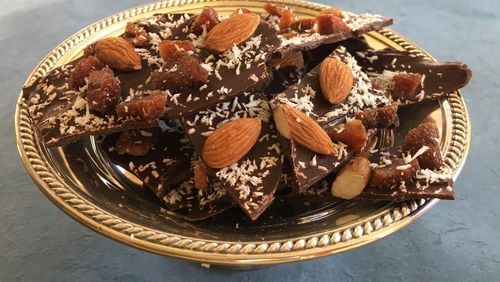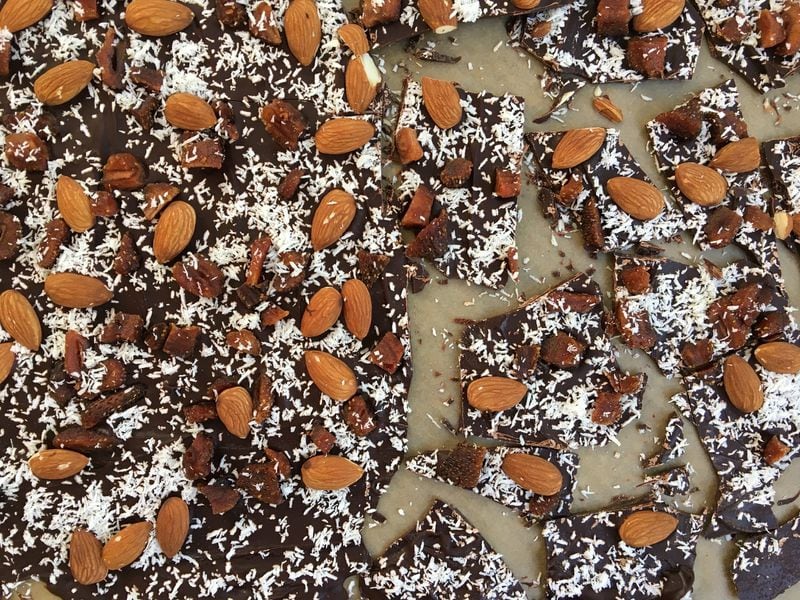I cling to the idea of dark chocolate as a health food with the same unwavering grip I use to hold my wineglass during book club. In my world, dark chocolate isn’t a dessert; it’s a free-radical-combating antioxidant delivery mechanism. In fact, every day, around 4 p.m., I feel really low on antioxidants, and thank my lucky stars that dark chocolate is there with me to fight the good fight.
During a recent mouthful, I wondered if “healthy chocolate” was, perhaps, a delusional oxymoron, like “flattering jeans” and “yummy kale recipe.” So I did a little research on the sweet treat. Both dark and milk chocolate are made from cacao, the raw powder that has been cold-pressed from cacao beans. And if right now you’re furrowing your brow because you thought chocolate came from cocoa, it’s all just science-y semantics: Cocoa powder is cacao powder that has been heated and processed.
Cacao contains flavonoids, which are the phytonutrients found in fruits and vegetables, and why I call my chocolate by its pet nickname, “salad.” Flavonoids promise a myriad of benefits, including reduced inflammation and improved heart function. Dark chocolate contains a higher percentage of flavonoid-blessed cacao than milk chocolate, hence its stellar reputation. The flavonoids in milk chocolate are diluted with added sugar and milk fats, hence milk chocolate’s reputation for being sort of sad. Now, here’s where the healthy judgment call gets murky. I was surprised to learn that milk chocolate actually has less fat and fewer calories per ounce than dark chocolate. So I suggest eating dark chocolate for the flavonoids. But eat a little less of it at a time, say, a mere half-ounce of dark chocolate fruit and nut bark.
Even if you are a terrible baker, I promise you can make chocolate bark. Start with a chocolate bar from the baking aisle in your local market, and save the Hershey bars for Halloween. Break your chocolate into little pieces, and place it in a microwave-safe bowl. Listen up, because this is important: You want to heat your chocolate at 50 percent power in small time increments, and stir it after every zap. Resist the urge to cook it on high for a solid 5 minutes, or your chocolate will scorch, and you will be even sadder than milk chocolate.
Which chocolate bar should you choose? The higher the cacao percentage, the more health benefits you will enjoy. If you are vegan or hard core about avoiding refined sugar, choose a 100 percent cacao bar. You’ll want to add about 1/4 cup of maple syrup, or 1/2 cup of Stevia, to offset the bitterness. I am decidedly not hard core. So I recommend bittersweet chocolate, which is 60 percent cacao. It’s at the lower end of what is considered dark chocolate, but on the plus side, it doesn’t taste like dirt.
Pour your melted chocolate onto a pan lined with parchment paper and press your favorite toppings into it. I am obsessed with dried strawberries and coconut flakes, but if you’re not, use an equal amount of dried apricots and sunflower seeds instead. Allergic to nuts? Skip them, and add 2 ounces of dried blueberries plus a splash of mint extract for brightness. Feel free to experiment with fresh fruit, too. The seeds from half a fresh pomegranate will pair beautifully with the dark chocolate. Just be sure to serve your bark the same day you make it, since fresh fruit won’t keep as long as dried. In fact, you can add an ounce or two of any topping your healthy heart desires.
The only hard rule is to limit your liquid extracts to a teaspoon each, or you risk overwhelming the chocolate flavor. And I mildly suggest toasting any nuts in a dry skillet before adding them, because browned nuts impart a mellow, nutty flavor. But if prep time is a luxury you can’t afford, skip the toasting and move on to the chilling and eating.
No matter how you top it, this chocolate bark is rich and luxurious, without being cloyingly sweet. And, yes, a half-ounce serving really is enough to make you feel satisfied. You can share the love by giving your homemade chocolate bark as a thoughtful hostess gift or an inexpensive teacher gift. Just be sure to make an extra batch for yourself. You know, for good health.
About the Author







